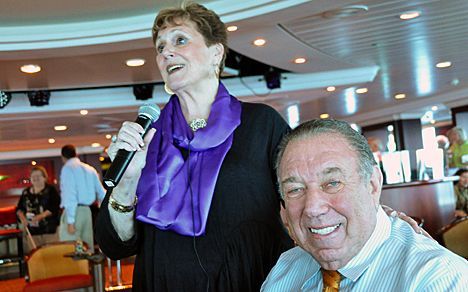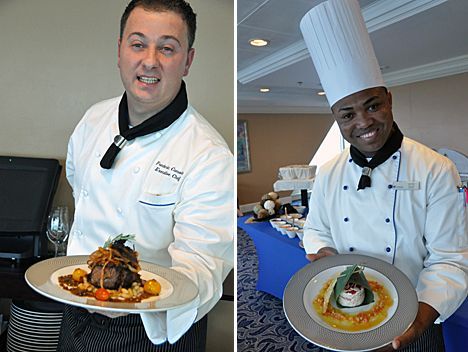Article
Living and Learning on the High Seas
Author(s):
One doesn't expect Las Vegas-style extravaganzas on small ship cruises. Instead, this cruise line offers intimate enrichment lectures that feed the soul ... as well as the stomach.
Photography by the authors.
One doesn’t expect Las Vegas-style extravaganzas on small ships cruising the oceans, yet the cruise director has to do something for all those days at sea. Boutique cruise lines, such as the recently developed Azamara Club Cruises, turn what could be a limitation into an advantage: Intimate enrichment lectures on subjects probably very interesting to the clientele on board their two 694-passenger ships.

Larry Pimentel, the former CEO of both Cunard and Seabourn Cruise Line is now the president and chief executive of Azamara Club Cruises. “It’s a boutique upscale cruise line,” he says. “We are essentially the river boats of the deepwater sector.”
The cabins and suites are empty on the Azamara Journey, for example, as she heads south past the tip of Baja California on her way to Mazatlan. Passengers are comfortably settled into the spacious Cabaret lounge ready for some insider stories on surely everyone’s favorite composer, Cole Porter. The guests are waiting for Marlene and Chester Solender, music historians and entertainers who have a series of programs about the Broadway stage to sing and play for them.
A married couple with a show business background, Chet is the pianist and perhaps the straight man, Marlene the singer who delivers amusing anecdotes with panache about the men

Says Marlene, “Rogers and Hammerstein brought something different to Broadway, songs that advanced the story line, that challenged racial barriers and one (Oklahoma) even winning the Pulitzer Prize and becoming a state song.”
Her tales include accounts of a young Mary Martin singing, “My Heart Belongs to Daddy,” while a young Gene Kelly dances in the chorus (in Cole Porter’s Leave It to Me) and answers the question: In a Broadway collaboration, which comes first, the lyrics or the music? Answer: It depends. With Richard Rogers and Lorenz Hart, she says, Rogers wrote the music then Hart added the lyrics, but when Hart tragically died in 1943 Rogers turned to an old friend Oscar Hammerstein II, who wrote the lyrics first before Rogers composed the music.
And what a partnership that was, says Marlene. The two had much in common: similar interests and similar ambitions. Neither smoked nor drank. Each had a grandfather who influenced their lives. Both had wives named Dorothy who were interior designers, and met their husbands for the first time on an ocean liner. Rogers’ father was an OB-GYN and delivered both of the Hammerstein’s babies. The last song for The Sound of Music was “Edelweiss.” Rogers brought the finished piece to his partner when Hammerstein lay terminally ill with stomach cancer and surely that beautiful melody would comfort any dying man.

Lecturer Christofferson has been studying the Sea of Cortez for many years “both below and above the water,” he says. It was created by the San Andreas Fault.
Another guest lecturer, Jay P. Christofferson, a tall gangly college professor of zoology, declares to his audience with regret, “We know more about the moon than our own planet.” He describes the fascinating desert life around the Sea of Cortez and shows how both plants and animals manage to survive the heat and humidity in a hostile land. The animals are like humans: If it gets too hot, enzyme systems shut down. Asked, “Are we humans poor examples of adapting to a difficult habitat?” he replies, “Yes, but we’ve not had as long as life around the Sea of Cortez to adapt. It’s had millions of years.”
Later Jerri Pieretti, a crime-scene technician, tries to explain how a photograph might well be worth a thousand words to the investigating “CSIs.” Asked why investigators are portrayed in movies and TV as going through a situation using flashlights when they could have easily flipped a light switch, Pieretti explains that if a crime scene is discovered with the lights out, it has to be investigated with the lights out.
“Sounds like Inspector Clouseau at work!” murmurs one of the listeners. Pieretti was concerned that any slides showing mayhem might be too much for his audience, but an hour later many of the same persons are sitting in the Aqualina restaurant watching how to cook

“You need to like cooking,” both chefs say. “What should we do in our kitchen to produce meals like you?” passengers ask. “Invite me!” the executive chef, replies with a grin.
In another demonstration, executive chef Frederick Camonin and his sous-chef Hector show how they will, respectively, prepare one of the evening’s special meat courses and an extraordinary appetizer. Frederick’s suggestion to succeed with a singular dish makes sense: “Have all the ingredients ready at the beginning,” he says, “so you can take your time.” Hector’s advice in turn is, “Put your heart into everything you prepare. Food is love!”
More is the pity. Who doesn’t gain weight on a cruise? Said a cruise director once to his audience, we’d hope in a joke, “You come aboard as passengers and leave as ballast!”

Says Tache, it takes the five Ss to enjoy wine, “The sight, swirl, swish, sniff and savor!”Nevertheless, confident there are no calories in wine, passengers also have an opportunity to discover more about wines from Laurentia Tache, the ship’s articulate and enthusiastic sommelier from Romania (although, despite her 30 years, she looks too young to be sampling wine.) Guests try a 2009 Kato Sauvignon Blanc, Marlborough (New Zealand); a 2009 Gérard Bertrand Chardonnay Reserve Speciale, Languedoc-Roussillon (France); a 2004 Melini Chianti Classico Laborel, Chianti (Italy) and a 2008 Stellenzicht Pinotage Golden Triangle (South Africa) from one of the oldest wineries in the country.
Passengers have reason to be interested in the ship’s wines: The Azamara Journey doesn’t charge for wine at lunch and dinner;
and, unlike many cruise lines, it doesn’t charge either for specialty coffees, sodas or bottled water.
The Andersons, who live in San Diego, are the resident travel & cruise columnists for Physician's Money Digest. Nancy is a former nursing educator, Eric a retired MD. The one-time president of the New Hampshire Academy of Family Practice, Eric is the only physician in the American Society of Travel Writers. He has also written five books, the last called The Man Who Cried Orange: Stories from a Doctor's Life.




